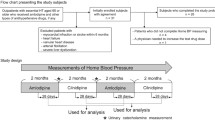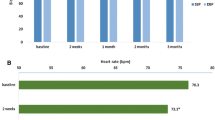Abstract
The aim of the study was to examine the efficacy of a new controlled release formulation of diltiazem administered in a twice-daily dose in patients with essential hypertension using 24 hour intra-arterial ambulatory blood pressure monitoring.
Sixteen patients (2 female) of mean age 53 years with mild to moderate essential hypertension, defined as a supine resting diastolic cuff blood pressure ≥95 mm Hg, were recruited to a sequential dose ranging study of controlled release (CR) diltiazem. After a six week run-in period without any anti-hypertensive medication, intra-arterial blood pressure monitoring with 60° tilt, isometric handgrip and bicycle exercise testing were performed. Patients were then treated for one week with CR diltiazem 120 mg b.i.d. If supine resting diastolic cuff blood pressure fell by <10 mm Hg compared to the last run-in value and remained >90 mm Hg, the dose was increased to 240 mg b.i.d. for a week, and if necessary to 360 mg b.i.d. for a week. Patients continued for further one month on the dose of CR diltiazem at which they achieved target blood pressure reduction. At the end of this maintenance treatment, 24 hour intra-arterial blood pressure monitoring was repeated.
Twelve patients were satisfactorily controlled on 120 mg b.i.d. CR diltiazem, three on 240 mg twice daily and one on 360 mg twice daily. During rest and exercise, blood pressure and heart rate were significantly lower after treatment with CR diltiazem than before treatment. The hypotensive effect of diltiazem was maintained throughout the 12 hour dosing interval and the early morning blood pressure response was blunted. No adverse effects or ECG abnormalities were reported.
It was concluded that CR diltiazem 120 mg, administered twice daily to a total daily dose of between 240 mg and 720 mg, is effective and well tolerated in the treatment of mild to moderate essential hypertension.
Similar content being viewed by others
References
Singh BN, Ellrodt G, Nademanee K (1984) Calcium antagonists: cardiocirculatory effects and therapeutic applications. In: Hurst JW (ed) Clinical essays on the heart, vol 2. McGraw-Hill, New York, pp 65–97
Posma JL, Van Dijk RB, Lie KI (1989) Sustained-release diltiazem versus metoprolol in stable angina pectoris. Eur Heart J 10: 923–927
Wheatley D (1985) A comparison of diltiazem and atenolol in angina. Postgrad Med J 785–789
Weiner DA, Cutler SS, Klein MD (1986) Efficacy and safety of sustained-release diltiazem in stable angina pectoris. Am J Cardiol 57: 6–9
Klinke WP, Kvill, Dempsey EE, Grace M (1988) A randomised double-blind comparison of diltiazem and nifedipine in stable angina. J Am Coll Cardiol 12: 1562–1567
Subramanian VB (1982) Calcium channel blockers in chronic stable angina. Herz 7: 211–220
Ginsberg D, Pappas JE, Rofman BA, et al (1988) Once-daily dosing of sustained release diltiazem capsules in mild-to-moderate hypertension. JAMA 88: 1489–1492
Weir MR, Josselson J, Giard MJ, et al (1987) Sustained-release diltiazem compared with atenolol monotherapy for mild to moderate systemic hypertension. Am J Cardiol 60: 361–411
Nikkila MT, Inkovaara JA, Heikkinen JT, Olsson SOR (1989) Antihypertensive effect of diltiazem in a slow-release formulation for mild to moderate essential hypertension. Am J Cardiol 63: 1227–1230
Pool PE, Herron JM, Rosenblatt S, et al (1989) Sustained-release diltiazem: duration of antihypertensive effect. J Clin Pharmacol 29: 533–537
Greenburg RN (1984) Overview of patient compliance with medication dosing: a literature review. Clin Ther Res 6: 592–599
Littler WA, Komsuoglu B (1989) Which is most accurate method of measuring blood pressure? Am Heart J 117: 723–728
Gould BA, Mann S, Davies AB, Altman DG, Raftery EB (1981) Does placebo lower blood pressure? Lancet II: 1377–1381
Millar Craig MW, Hawes, Whittington J (1978) New system for recording ambulatory blood pressure in man. Med Biol Eng Comput 16: 727–731
Wilcox J (1982) Observer factor in the measurement of blood pressure. JAMA
Raftery EB (1974) Problems of measuring blood pressure in clinical trials. In: Hypertension its nature and treatment. CIBA Laboratories, Horsham, England, pp 219–226
Grimley-Evans J (1970) Experience with the random zero sphygmomanometer. Br J Prev Soc Med 24: 10–15
Labarthe DR, Hawkins CM, Remington RD (1973) Evaluation of performance of selected devices for measuring blood pressure. Am J Cardiol 32: 546–553
Casadei R, Parati G, Pomidossi G, Groppellic A, Tazzi S, Mancia G (1988) 24 hour blood pressure monitoring: evaluation of spacelabs 5300 monitor by comparison with intra-arterial blood pressure in ambulant subjects. J Hypertension 6: 797–803
Berhand G, BeFaire U, Castenfarc J, Anderson G, Hartford M, Liedholm H, Ljinngmann D (1985) Monitoring 24 hour blood pressure in a drug trial. Evaluation of a non-invasive device. Hypertension 7: 688–694
Sokolow M, Werdegar D, Klain J, Hinman A (1966) Relationship between level of blood pressure measured casually and by portable recorders and severity of complications in essential hypertension. Circulation 34: 279–298
Mann S, Millar-Craig M, Raftery EB (1985) Superiority of 24 hours measurement of blood pressure over clinic values in determining prognosis in hypertension. Clin Exp Hypertension 7: 279–281
Mann S, Millar-Craig M, Balosubramanian V, Raftery EB (1981) Once daily β-adrenergic blockade in hypertension: an ambulatory assessment. Br J Clin Pharmacol 12: 223–228
Jones RI, Hornung RS, Cashman PMM, Raftery EB (1985) Effect of enalapril at rest, during tilt, static and dynamic exercise in systemic hypertension. Am J Cardiol 55: 1534–1538
O'Brien E, O'Malley K, Cox J, Stauton A (1991) Ambulatory blood pressure monitoring in the evaluation of drug efficacy. Am Heart J 121: 999–1006
Author information
Authors and Affiliations
Rights and permissions
About this article
Cite this article
Sridhara, B.S., Thomas, P., Lahiri, A. et al. Antihypertensive efficacy of twice daily controlled release diltiazem using 24 hour intra-arterial blood pressure monitoring. Eur J Clin Pharmacol 46, 427–430 (1994). https://doi.org/10.1007/BF00191905
Received:
Accepted:
Issue Date:
DOI: https://doi.org/10.1007/BF00191905




